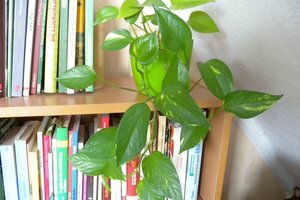Indoor plants for the north window
If you want to green a living room with a north window, you have to make the right choice of indoor plants. Species hungry for light are too dark here. Still, several plants can handle poor light if you care for them properly.

North windows are not suitable for plants? This is not true if you make the right choices and meet the other needs of the foster family. In addition to light, temperature and watering also play an important role.
Coordinate light, temperature and watering
- Houseplants have very different needs depending on their origin. Some species need a lot of light to feel comfortable, but some robust fosterlings can also tolerate a dark location. For them, a place directly on the window sill of a north window is a good place to develop magnificently.
- Dark rooms are often cool rooms too. For the indoor plants standing there, this means that they grow a little slower and therefore require less nutrients and water. Many plants wither because they get too much rather than too little water. Especially with plants that are supposed to grow in difficult locations, it is important that you adjust the water and nutrient inputs to the light and temperatures.
- Whether a plant needs a lot of light or gets by with less can already be seen from the leaves. Indoor plants with large, green leaves need less light because their leaf surface absorbs more of it. Plants with small leaves are often sun-hungry. All plants with variegated foliage also need more light. Pay attention to whether you are buying, for example, a simple green room ivy or a white-green leafy one. The colorful variants need more light, but still cannot stand full sun.
- Especially with plants that are supposed to thrive on a north window, it is important that their leaves can absorb all the light that is available. Therefore, you should regularly remove dust from the foliage. Small plants are grateful for a shower, large leaves can be wiped off with a damp cloth.
Green lily for the cat - you should pay attention to this
It is the suffering of many cat owners that the house tigers are constantly ...
Shade plants for the north window
- The window leaf (Monstera delicosa) is known as a particularly robust houseplant. The plant forms very large leaves and becomes more and more shade-friendly with age. The young leaves are still heart-shaped, later huge, deeply slit leaves can develop. Monstera also tolerates a cooler location in the stairwell, as long as the temperatures do not drop below ten degrees.
- The cobbler palm (Aspidistra elatior), which got its name because it willingly tolerates cold and drafty shop windows as a location, is just as robust. Like the Monstera, however, it is not long a plant for the window sill, because there is soon no longer enough space here. Both species can become large specimen plants near the north window. A monstera can grow up to the ceiling, the cobbler palm forms dense clumps in the bucket that can be up to one meter high.
- If you'd rather look for smaller houseplants for the north window, place indoor ivy. Purely green varieties are very shade-friendly. The plant forms long tendrils that you can grow around an arch of wire. So the room ivy also has space on a narrow window sill.
- Various types of begonia, hen with chicks (Tolmiea menziesii) or the harp bush (Plectanthus) remain just as small. They are typical plants for a shady, airy place. The green lily is also robust and shade-tolerant. However, the air in the room must not be too dry, otherwise the tips of the long leaves will dry out.
- The trade offers numerous indoor plants for partially shaded and warm locations. Dieeffenbachia, purple turkey (Syngonium), cob thread (Aglaonema), dragon tree (Dracaena species), dwarf pepper (Pepromia species), tree friend (Philodendron) and the Efeutute (Epipremnum pinnatum) are examples here called.
- The flamingo flower (Anthurium species) or the African violet (Saintpaulia ionantha) can bring color in the penumbra. If these plants are at the north window, they may need a lighter location to recover after a while. Try out whether it is possible to temporarily animate the north window with these species.
- Last but not least, the ferns must not be forgotten here. There are many species with impressive fronds of ferns. Most of the species, however, want high humidity. A bathroom with a north window may be a suitable place for them. Ask your specialist dealer which type of fern is right for you.
How helpful do you find this article?


